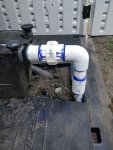Hello, I am looking for suggestions on how to re-work my pump inlet plumbing (hayward super pump). As you can see in the attached photo, someone previous to me decided that a DWV rubber coupling was the best option. It did work fine for a while, but I have been getting some suction side leakage so I want to replace it.
Its flexible PVC to a 45 fitting (appears glued and clamped) to the DWV coupling to the pipe inlet. The biggest issue is that the pipe inlet sits just a bit higher than the 45 so the DWV coupling is not fully attached on either side.
I am working with limited room as its very close to the front of my shed and my plumbing experience is limited.
What is the best way to reconfigure this?
Thanks

Its flexible PVC to a 45 fitting (appears glued and clamped) to the DWV coupling to the pipe inlet. The biggest issue is that the pipe inlet sits just a bit higher than the 45 so the DWV coupling is not fully attached on either side.
I am working with limited room as its very close to the front of my shed and my plumbing experience is limited.
What is the best way to reconfigure this?
Thanks



